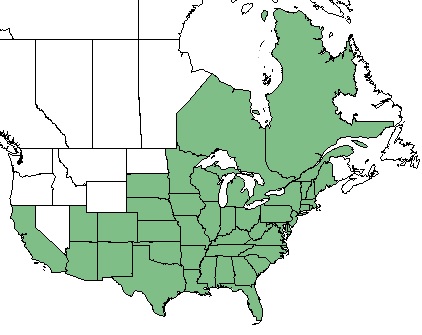Difference between revisions of "Asclepias tuberosa"
(→Distribution) |
|||
| Line 26: | Line 26: | ||
<!-- Basic life history facts such as annual/perrenial, monoecious/dioecious, root morphology, seed type, etc. --> | <!-- Basic life history facts such as annual/perrenial, monoecious/dioecious, root morphology, seed type, etc. --> | ||
==Distribution== | ==Distribution== | ||
| + | This species is found from Quebec and Maine, westward to Ontario and Minnesota, southwestward to South Dakota, Colorado, Utah, Arizona, and California, and southward to central Texas, the Gulf Coast, and peninsular Florida.<ref name="USDA"/> | ||
| + | |||
==Ecology== | ==Ecology== | ||
===Habitat=== <!--Natural communities, human disturbed habitats, topography, hydrology, soils, light, fire regime requirements for removal of competition, etc.--> | ===Habitat=== <!--Natural communities, human disturbed habitats, topography, hydrology, soils, light, fire regime requirements for removal of competition, etc.--> | ||
Revision as of 13:35, 13 February 2018
| Asclepias tuberosa | |
|---|---|

| |
| Photo by the Atlas of Florida Plants Database | |
| Scientific classification | |
| Kingdom: | Plantae |
| Division: | Magnoliophyta - Flowering plants |
| Class: | Magnoliopsida - Dicots |
| Order: | Gentianales |
| Family: | Asclepiadacea |
| Genus: | Asclepias |
| Species: | A. tuberosa |
| Binomial name | |
| Asclepias tuberosa (L) Brittonex Vail | |

| |
| Natural range of Asclepias tuberosa from USDA NRCS Plants Database. | |
Common Names: midwestern butterfly-weed; sandhills butterfly-weed; common butterfly-weed;[1] butterfly milkweed[2]
Contents
[hide]Taxonomic Notes
Varieties: A. tuberosa var. interior; A. tuberosa var. rolfsii; A. tuberosa var. tuberosa[1]
Synonyms: A. rolfsii; A. decumbens[1]
Description
Distribution
This species is found from Quebec and Maine, westward to Ontario and Minnesota, southwestward to South Dakota, Colorado, Utah, Arizona, and California, and southward to central Texas, the Gulf Coast, and peninsular Florida.[2]
Ecology
Habitat
A. tuberosa occurs in dry forests, roadbanks, sandhills, woodland margins, roadsides, and pastures.[1]
Phenology
In the southeastern and mid-Atlantic United States, A. tuberosa flowers from May through September and fruits from August through September.[1]
Conservation and Management
Cultivation and restoration
Photo Gallery
References and notes
- ↑ Jump up to: 1.0 1.1 1.2 1.3 1.4 Weakley AS (2015) Flora of the Southern and Mid-Atlantic States. Chapel Hill, NC: University of North Carolina Herbarium.
- ↑ Jump up to: 2.0 2.1 USDA NRCS (2016) The PLANTS Database (http://plants.usda.gov, 13 February 2018). National Plant Data Team, Greensboro, NC 27401-4901 USA.